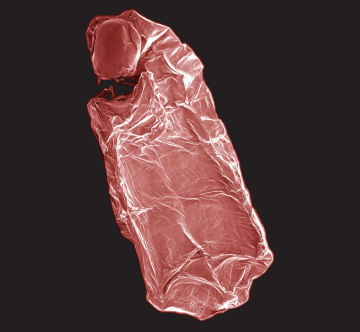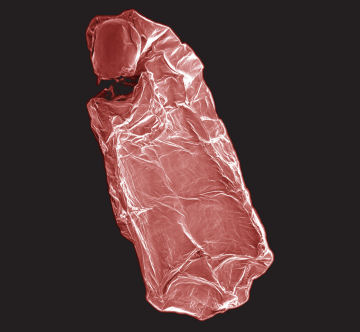Sugary survival skill
Scientists have discovered the trick that an African fly uses to survive dry times.
By Susan Gaidos
Dehydration dooms most animals. Humans, for example, die if their bodies lose about 12 percent of their water. But some tough little critters can get through long periods of drought. One bug survives dry times by entering a dehydrated state. Now, scientists have discovered the sugary secret behind this feat.
The larvae of an African fly known as Polypedilum vanderplanki live in the bottom of rain puddles in the African desert. When the dry season hits, and their habitats dry up, they can endure an almost complete loss of body water. They can persist in this dormant state, which is similar to a very deep sleep, for up to 17 years.
Just add water, and before long the dead-looking critters are moving and feeding again.
 |
|
Curled up into a 4 millimeter–long mummy, this fly larva can suspend its life for years, withstanding severe drought and extreme temperatures.
|
| Daisuke Tanaka/National Institute of Agrobiological Sciences in Japan |
Most other animals that have been known to freeze-dry—sea monkeys (brine shrimp) and water bears (tardigrades), for example—are microscopic. Biologists have known for years that a sugar called trehalose plays a role in the drought-survival tactics of these species.
In water bears and sea monkeys, small command centers of cells remain hydrated during dormancy. In cells throughout the rest of the body, however, water is replaced with the sugar trehalose.
How does this special sugar allow cells, let alone small creatures, to survive? Scientists have long thought trehalose keeps the cells from falling apart by turning into a glassy state. This state is much like melted table sugar that has solidified into hard candy drops. A series of new studies show that’s exactly what happens in the fly P. vanderplanki.
Takashi Okuda of the National Institute of Agrobiological Sciences in Tsukuba, Japan, and his collaborators collected P. vanderplanki—which look more like mosquitoes than flies—and got them to breed in the lab. This provided a steady supply of young larvae for the scientists to study.
The researchers then used a technology called infrared imaging to visualize and measure the amount of water and heat in the larvae’s tissues. The study showed that the trehalose was uniformly distributed throughout P. vanderplanki‘s bodies.
When the researchers turned up the heat, they found the larvae’s absorption of heat peaked at around 70° Celsius (158° Fahrenheit). That’s the same temperature at which solid table sugar begins to melt. The findings showed that the trehalose sugar had, indeed, been in a glassy state.
A second experiment showed that trehalose sugars had bonded with the cells’ outer layer or membrane. This protected the cells’ insides from extreme distortion during dehydration.
Okuda says he and others would like to steal P. vanderplanki‘s secret to learn, for example, how to store people’s blood in a dried form until it is needed for medical uses such as transfusions. The main challenge, he says, is to get trehalose to penetrate the membranes of red and white blood cells. If this could be done, the dehydration technique could eventually be used to preserve entire organs.
Power Words
From The American Heritage® Student Science Dictionary, The American Heritage® Children’s Science Dictionary, and other sources.
dehydration The process of losing or removing water or moisture.
dormant state An inactive state in which growth stops and metabolism is slowed.
habitat The area or natural environment in which an animal or plant normally lives, such as a desert, coral reef or freshwater lake.
heat absorption The process of taking in heat and holding it. During the day the Earth takes in and stores heat from the sun through absorption.
infrared Relating to the visible part of the electromagnetic spectrum with wavelengths longer than those of visible red light but shorter than those of microwaves.
larva An animal in an early stage of development that differs greatly in appearance from its adult stage. Larvae are adapted to different environments and ways of life than adults and go through a process of metamorphosis to change into adults.
transfusion The transfer of blood from one person to another, often to replace blood lost due to injury or surgery.
 |
Copyright © 2002, 2003 Houghton-Mifflin Company. All rights reserved. Used with permission.
Going Deeper:
Castelvecchi, Davide. 2008. Live another day: African insect survives drought in glassy state. Science News 173(March 29):197. Available at http://www.sciencenews.org/articles/20080329/fob5.asp .
Sohn, Emily. 2005. Putting a mouse on pause. Science News for Kids (April 27). Available at http://www.sciencenewsforkids.org/articles/20050427/Note2.asp .
______. 2004. A dire shortage of water. Science News for Kids (Aug. 25). Available at http://www.sciencenewsforkids.org/articles/20040825/Feature1.asp .
______. 2004. Prime time for cicadas. Science News for Kids (May 19). Available at http://www.sciencenewsforkids.org/articles/20040519/Feature1.asp .







